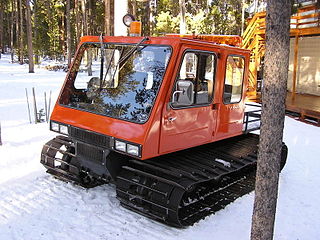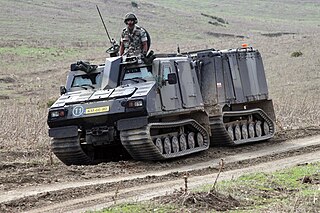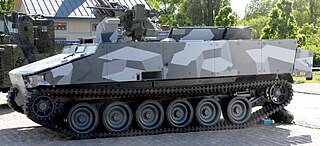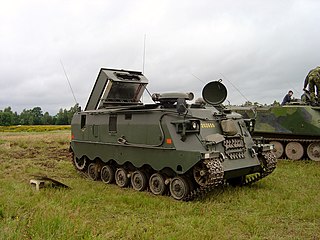
An amphibious vehicle is a vehicle that is a means of transport viable on land as well as on or under water. Amphibious vehicles include amphibious bicycles, ATVs, cars, buses, trucks, railway vehicles, combat vehicles and hovercraft.

The Patria Pasi is a Finnish-made six-wheeled armoured personnel carrier (APC) originally designed for Finnish Defence Forces. The first variant was produced in 1983 and serial production began in 1984. It was designed to operate with ease of use, simple structure and low-cost maintenance. The basic appearance and configuration of the Pasi is similar to most other wheeled APCs. The XA-180 and XA-185 are fully amphibious while other variants are not.

Ski warfare is the use of ski-equipped troops in war.

The Tucker Sno-Cat is a family of tracked vehicles for snow conditions, manufactured in Medford, Oregon by the company of the same name.

A snowcat is an enclosed-cab, truck-sized, fully tracked vehicle designed to move on snow. Major manufacturers are PistenBully (Germany), Prinoth (Italy) and Tucker.

Bandvagn 206 is a tracked articulated, all-terrain carrier initially developed and manufactured by the Swedish company Hägglund & Söner, and subsequently by BAE Systems Hägglunds, for the Swedish Army. It consists of two units, with all four tracks powered. It can carry up to 17 people, 6 in the front compartment, 11 in the rear. The trailer unit can be adapted for different uses.

BAE Systems AB is subsidiary holding company for the Swedish assets of BAE Systems Land & Armaments, whose ultimate parent is the British defence contractor BAE Systems.
Valtra is an agricultural machinery manufacturer based in Äänekoski, Finland. Valtra's products include tractors, combine harvesters, sugar cane harvesters, self-propelled sprayers and seed drills. Valtra has been part of the American AGCO Corporation since 2004.

Pansarbandvagn 302, meaning roughly armoured tracked carrier vehicle 302, was a Swedish high-mobility infantry fighting vehicle used by the Swedish Army from 1966 to 2014.

The Snow Trac is a small personal Snowcat that is roughly the size of a modern compact car.

The Nasu is a tracked articulated, all-terrain transport vehicle developed by Sisu Auto for the Finnish Army. It consists of two units, with all four tracks powered. It can carry up to 17 people, although the trailer unit can be adapted for different applications. There are two main versions, the NA-140 BT and the NA-110.

An articulated hauler, articulated dump truck (ADT), or sometimes a dump hauler, is a very large heavy-duty type of dump truck used to transport loads over rough terrain, and occasionally on public roads. The vehicle usually has all-wheel drive and consists of two basic units: the front section, generally called the tractor, and the rear section that contains the dump body, called the hauler or trailer section. Steering is made by pivoting the front in relation to the back by hydraulic rams. This way, all wheels follow the same path, making it an excellent off-road vehicle.

The BvS10 is a tracked articulated amphibious all-terrain armoured vehicle produced by BAE Systems Land Systems Hägglunds of Sweden. This vehicle, referred to as the All Terrain Vehicle (protected) - ATV(P) or Viking by the UK forces, was originally developed as a collaboration between industry - Hägglunds Vehicle AB - and the British Ministry of Defence (MoD) on behalf of the Royal Marines.

The Bronco All Terrain Tracked Carrier (ATTC) is a twin chassis multi-purpose tracked articulated vehicle jointly developed by ST Kinetics and the Defence Science and Technology Agency (DSTA) for the Singapore Army. The variant which was in service as a UOR with the British Armed Forces is known as the Warthog.

The SEP modular armoured vehicle, Swedish for "Fragmentation Protected Standard Platform", is a hybrid diesel-electric powered armoured fighting vehicle developed by BAE Systems AB. The vehicle is codenamed "Thor". The first demonstration models were produced in 2000 (tracked) and 2003 (wheeled). It was originally contracted by the Swedish Defence Materiel Administration. The series-hybrid electric drivetrains for both the wheeled (SEP-W) and two generations of tracked (SEP-T) vehicles were designed and manufactured by MAGTEC . SEP-W was equipped with in-wheel HMED units, each rated at over 100 kW and producing 20,000Nm at each wheel in low range. This performance gave the vehicle individual wheel speed, position and torque control, providing electronic limited-slip differential, torque-vectoring, and importantly on-demand skid-steering, enhanced packaging and protection, and greatly improved suspension travel. SEP-T was equipped with a novel 'cross-drive' pack incorporating concentric twin-traction and twin-steer motors, giving fully electric 'drive by wire' steering via the outboard gearboxes. In both types of vehicle, two high-performance diesel engine/generator sets were installed, providing dual redundancy and further protecting driver and co-driver from side ballistic impacts/penetration. Power scheduling and operating points for the generator sets provided optimised fuel usage and performance, thus reducing the requirements for refuelling support in the field. The design of the drivetrains in both vehicle types permitted novel vehicle architectures and optimised crew and payload packaging, without compromising suspension/transmission design or performance.

The Vityaz DT-30 is a multi-purpose articulated tracked carrier developed in the Soviet Union. It was designed to carry heavy loads in difficult terrain like swamps, sand and snow in extreme weather conditions.
The Patria Pasi is a military armoured personnel carrier. It was the choice of the Finnish Defence Forces to replace its aging Soviet BTR-60s. It was a result of the commercial competition between two Finnish companies, a tractor manufacturer Valmet and the lorry manufacturer Sisu, which won the contract with its prototype.

The Pansarvärnsrobotbandvagn 551 was a tank destroyer developed by Landsverk and Hägglund & Söner.

A tracked articulated vehicle or articulated tracked vehicle, is a variation of a continuous track vehicle that consists of two cars, each with their own track, most commonly with an actuated linkage in between. This configuration allows an articulated tracked vehicle to turn by articulating the swivel joint in between the two vehicles, as opposed to using differential steering to move one track faster than the other.


















